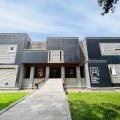NATIONAL MUSEUM OF MEDIEVAL ART
Albania's finest museum houses one of the world's most important collections of icons ( centuries). Meticulously presented.
This museum (Muzeu Kombëtar i Artit Mesjetar) is unique in the Balkans. Created during the communist period (1987), it houses one of the world's largest collections of Christian art: 8,000 pieces, of which over a thousand are on display, mainly icons from the 14th to the 19th centuries. In the midst of the atheist period, these were removed from the Orthodox churches in the south-east of the country and stored in Korça. Since 2016, the museum has been housed in a modern building designed by German architect Julia Bolles-Wilson. Its meticulous presentation makes it Albania's finest museum.
TheGolden Hall. On the first floor, three gold-colored walls are entirely covered with hundreds of icons of all sizes, 8 m high. The architect has placed the sacred images in the context of today's image-saturated world: it's up to the visitor to choose. A promontory is provided with a legend for each work. Most of the icons are signed by the greatest Albanian painters: Konstantin Shpataraku (18th century), the Çetiri brothers (19th century), Mihal Anagnosti (19th century)... Particularly noteworthy is the Archangel Michael (no. 2213) by Konstantin Jeremonaku (early 18th century). There are also 14 works by the Zografi brothers (18th century): Entrée dans Jérusalem (no. 2176), Naissance de la Vierge (no. 5334), etc. At the foot of the main wall are three frescoes by the great Onufri (16th century), detached from the walls of the churches of Berat, Shelcan (near Elbasan) and Moscopole.
White balcony. Just above the Golden Hall is a series of icons and painted doors from churches in the Berat, Korça and Lake Prespa regions. These are some of the oldest pieces in the museum. They date from the 14th and 15th centuries, when artists did not yet sign their work. Three of them stand out: an Annunciation in which the Archangel Gabriel visits the Virgin in the middle of a... knitting session; a magnificent Archangel Michael, richly dressed and with an enigmatic face; and a Virgin and Child Odigitria ("showing the way").
Black Labyrinth. After the White Balcony, here we find eight icons from the Berat citadel painted by Onufri. The first major artist to sign his works in the 16th century, he initiated the movement known as the "Berat School". In each of the master's works, admire this very special red, the exact composition of which remains a mystery. The use of pink pigments makes it brilliant, highlighting even the darkest scenes, such as the Resurrection of Lazarus and the Baptism of Christ. In the same room, compare the "Onufri red" with that of two icons by Nicolas Onufri (the master's son), also from Berat.
Red room. Dominated by a carved wooden iconostasis (1819) from the Church of St. Nicholas in Rehova, near Ereska. The original icons have been replaced by others. Of particular note, however, is the scene of the Dormition of the Mother of God, featuring a detail typical of Albanian painters: the Archangel Michael cutting off the hands of the Jew Jephonias. On the walls, the work of three 18th-century artists already seen in the Golden Hall can be seen up close: Konstantin Shpataraku ("of Shpat"), Konstantin Jeremonaku ("the hieromonk") and Konstantin Zografi ("the painter"). Although they share the same first name, their styles are quite distinct. While Jeremonaku incorporates elements of Islamic art in his Christ Pantocrator, Shpataraku opts for a realistic approach, notably in the scenes from the life of the saint Jovan Vladimir: a cartouche recounts the episode of French merchants attempting to carry off on horseback the relics of this Serbian king and saint who ruled the Prespa region in the 11th century.
White and black rooms. These two rooms present an uncluttered summary of Albanian religious art. The Black Room contains the museum's oldest piece, a 14th-century painted door from the rock church on the island of Maligrad. In the White Room, the masterpiece by Athanas Zografi (18th century), the last great Albanian painter of the post-Byzantine period: "First Ecumenical Council and Battle of the Milvian Bridge - By This Sign You Will Conquer". The icon summarizes two key events in the history of Christianity. In the upper part, occupying three-quarters of the surface, the Council of Arles in 314, the first true assembly of Christian bishops. Emperor Constantine presided over the council, where Donatus the Great was excommunicated for schism, a decision evoked here by the gesture of the slap. Below, Constantine leads the troops to the Milvian Bridge, near Rome, on October 28, 312. The day before, Christ had appeared to him, showing him the Chrism (the intertwined Greek letters I and Χ, the initials of Jesus Christ) and announcing "By this sign you will conquer". During the battle, indeed, the miracle takes place. A minor error on the part of the painter, who shows a cross rather than Christ in the sky. But this is Athanas Zografi's response to another great painting, The Battle of Milvian Bridge, painted in 1524 by Raphael. Here, Athanas Zografi incorporates not only Italian Renaissance influences, but also the entire Orthodox and Oriental pictorial tradition. A masterpiece.
Did you know? This review was written by our professional authors.
Book the Best Activities with Get Your Guide
Members' reviews on NATIONAL MUSEUM OF MEDIEVAL ART
The ratings and reviews below reflect the subjective opinions of members and not the opinion of The Little Witty.


Museo in cui ci sono diverse opere d'arte, per lo più composte da iconografie.
Dai colori si evince che diverse iconografie sono state realizzate da Onufri.
Peccato aver avuto poco tempo per vedere questo museo, tornerò sicuramente.